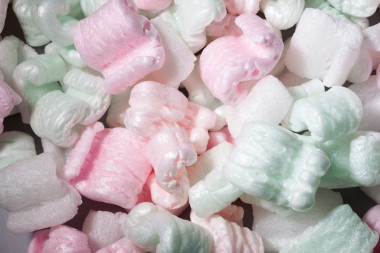Scientists turn packing peanuts into power

Batteries powered by the pesky polystyrene packing material? Researchers say their new process creates better batteries with less environmental impact..
Woe was the day in 1965 when Dow Chemical unleashed packing peanuts onto the world. For while the polystyrene foam packing material ensures the safe delivery of countless fragile items, peanuts have become an utter bane. Each year billions of them are dumped in landfills, with a paltry recycling rate of only 10 percent. And not only do they take generations to decompose, but polystyrene-based peanuts contain chemicals that are believed to be carcinogenic.
But now chemical engineers at Purdue University have found a novel way to recycle the pesky peanuts, reports Smithsonian.com; and they predict that in a mere five years we could be able to reuse some 50 percent of the peanuts that would otherwise be sent to the dump. They are using them to manufacture carbon anodes, a component of rechargeable batteries.
Vilas Pol, an associate professor at Purdue’s School of Chemical Engineering and lead author of the study, says his inspiration came from the peanuts themselves – of which the lab was getting plenty of along with shipments of supplies.
“We were getting a lot of equipment and chemicals contained in many boxes all full of packing peanuts, and at some point I realized that all these peanuts were going to waste,” says Pol. “We wanted to do something that was good for society and the environment.”
Diving into the composition of the material, they found that the primary components of packing peanuts are carbon, hydrogen and oxygen – at which point the team came upon the idea of trying to find a way to use the carbon to create an anode for a lithium ion battery. They discovered that by heating the peanuts under specific conditions, they were able to isolate the carbon, and were able to do so in a way as to dispose of the oxygen and hydrogen through water vapor and thus avoiding a hazardous environmental by-product. With additional heat, they were able to mold the carbon into thin sheets that were usable as a battery anode.
The new battery surprised the researchers by significantly exceeding their expectations. It stored more overall charge by 15 percent and charged more quickly than comparable lithium-ion batteries. The reasons for these advances? The process they came up with inadvertently altered the structure of the carbon to great advantage – an increased overall surface area capable of holding the lithium charge and increased spacing between the carbon atoms, which allows for a faster charge by giving the lithium ions better access to each carbon atom.
While not having a plethora of packing peanuts to contend with in the first place would be ideal, the researchers are excited about what they see as a positive environmental impact of reusing the peanuts. But they also note that the isolation of pure carbon from the peanuts requires dramatically less energy in comparison to the temperature required to produce conventional carbon used for battery anodes: 1,100 F compared to 3,600 to 4,500 F.
The team has applied for a patent and hopes to bring their technology to market in the next few years; in the meantime, they intend to look into other uses for the carbon, as well. “This is a very scalable process,” says Pol.
See more on the discovery in the video below:
http://www.treehugger.com
